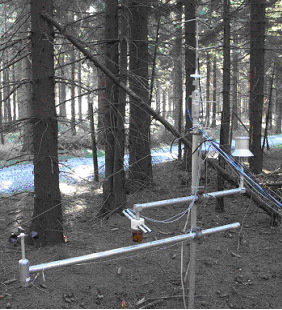ExchanGE processes in mountainous Regions - Intensive Observation Periode I
EGER-IOP1
From 07/2007 to 10/2007Experiment manager: Thomas Foken
Staff: Andrei Serafimovich, Lukas Siebicke, Katharina Köck (Staudt), Johannes Lüers, Stephanie Dix (Schier), Tobias Biermann, Johannes Olesch, Jens-Christopher Mayer
First intensive measuring campaign was carried out in the frame of EGER project in September-October 2007 at the Waldstein site. High-frequency turbulence measurements of horizontal and vertical wind components u, v, w, and sonic temperature Ts were performed using sonic anemometers and fast-response gas analyzers for density of carbon dioxide CO2 and water vapor H2O. Six systems were installed on the 36-m tall, slim tower at 0.10, 0.24, 0.56, 0.78, 1.0, 1.56 hc levels and one system was installed at the top of the 32-m tall tower at 1.39 hc level (canopy height hc = 25m).
Horizontal advection in the trunk space was determined by measuring wind speed and CO2 gradients. Five 2-m towers with cup anemometers, psychrometers, and CO2 inlets were installed along and across the mountain slope. Three towers were additionally equipped with sonic anemometers.
In addition to point measurements at the towers, acoustic and radioacoustic sounding measurements were performed with a remote sensing system consisting of a phase array Doppler Sodar DSDPA.90-64 with a 1290-MHz- RASS extension by Metek GmbH. This gave a mean profile of the wind vector and the acoustic temperature. The acoustic sounding system was located at a distance of approximately 250 m from the main and turbulence towers in a forest clearing.
In addition to the eddy-covariance measurements on top of the tower, the measurements at the main tower supplied meteorological data for in- and above canopy profiles of wind, temperature and humidity. Radiative fluxes were measured at the top of the tower and at 2 m within the canopy. Soil measurements comprised a soil temperature profile down to 2 m, soil moisture measurements down to 0.5 m and soil heat flux measurements.
The Advanced Canopy-Atmosphere-Soil Algorithm (ACASA), which was developed at the University of California, Davis, was used to model the turbulent fluxes of heat, water vapor and momentum within and above the canopy. This multi-layer canopy-surface-layer model incorporates a diabatic, third-order closure method to calculate turbulent transfer within and above the canopy.


Turbulence tower Advection mast

Sodar-RASS
Related links:
- Diploma Thesis: Besonderheiten der vertikalen Windverteilung am Waldstein
- Diploma Thesis: Multilevel investigation of subcanopy respiration flux by REA conditional sampling above and within a spruce forest
- Diploma Thesis: Parameterization of integral turbulence characteristics above and within a spruce stand
- Project: DFG Fo 226/16-1: Turbulence and stand scale modelling
